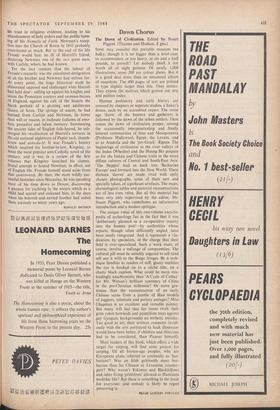Dawn Chorus
The Dawn of -Civilization. Edited by Stuart Piggott. (Thames and Hudson, 8 gns.)
SOME may consider this portable museum too bulky, though it is no bigger than a brief-case, to accommodate or too heavy, at six and a half pounds, to consult? Let nobody think it not worth all of eight guineas. Of nearly 1,000 illustrations, some 200 are colour plates. But it is a good deal more than an annotated album of snapshots. The 400 pages of text are printed in type slightly larger than this. They matter. They expose the motives which govern our arts and politics today.
Human prehistory and early history are covered by chapters or separate studies, a baker's dozen, each by an accredited expert. The stone age 'dawn' of the hunters and gatherers is followed by the dawn of the urban settlers. Then comes the dawn of civilisation proper, among the occasionally interpenetrating and finally lettered communities of Iran and Mesopotamia (Professor Mallowan), Egypt, the Levant, and so to Anatolia and the 'pre-Greek' /Egean. The beginnings of civilisation in the river valleys of the Indus (Wheeler) and the Huang Ho prepare us for the Indian and Chinese traits in the more diffuse cultures of Central and South-East Asia. 'The Steppes' lead us back into 'Barbarian Europe' and forward into the New World. These thirteen 'dawns' are made vivid with aptly chosen photographs, some of them new and specially taken, of significant artefacts. The maps, chronological tables and pictorial reconstructions are of less even value. But all this material has been very ably supervised by the editor, Mr. Stuart Piggott, who contributes an informative introduction and a modest epilogue.
The unique value of this one-volume encyclo- pedia of archwology lies in the fact that it was 'deliberately planned as a co-operative inquiry into the human past'—by authorities whose reports, though often differently angled, have been neatly integrated. And it represents a dication, by specialists, of the charge that their field is over-specialised. Such a work must, of course, involve a mélange of compromises. The cultural pill must be suitably sugared to 'sell (and sell out it will) to the Bingo fringes. By a tech- nique familiar to readers of stiff, glossy weeklies the eye is hooked on to a cliché title, on a chatty black caption. What could be more mis- leadingly anachronistic than 'A Cycle of Cathay' for Mr. Watson's brilliant summary of China in the pre-Christian millennia? Or more gro- tesque than the reconstruction of an early Chinese scene from a jumble of Han models of jugglers, minstrels and pottery cottages? Miss Chapman is an excellent and versatile painter. But many will feel that her insets (with their grim robot hominids and pointilliste trees against gay Gauguin backgrounds) an Lesthetic mistake. Too good as art, their artiness competes invidi- ously with the arts portrayed (a hack illustrator would have been better, if children and illiterates had to be considered, than Picasso himself).
Most readers of this book, which offers a wide target for sniping, will find some pretext for carping. Of all bronze-age peoples, why are Europeans alone referred to constantly as 'bar- barians'? Was an Irish goldsmith more bar- barous than his Chinese or Levantine counter- part? Why weren't Eskimos and Blackfellows and other living 'primitives' allowed to illuminate neolithic life? But there is something in the book for everyone; and nobody is likely to regret possessing it.
HUGH GORDON PO1(1 EUS






































 Previous page
Previous page